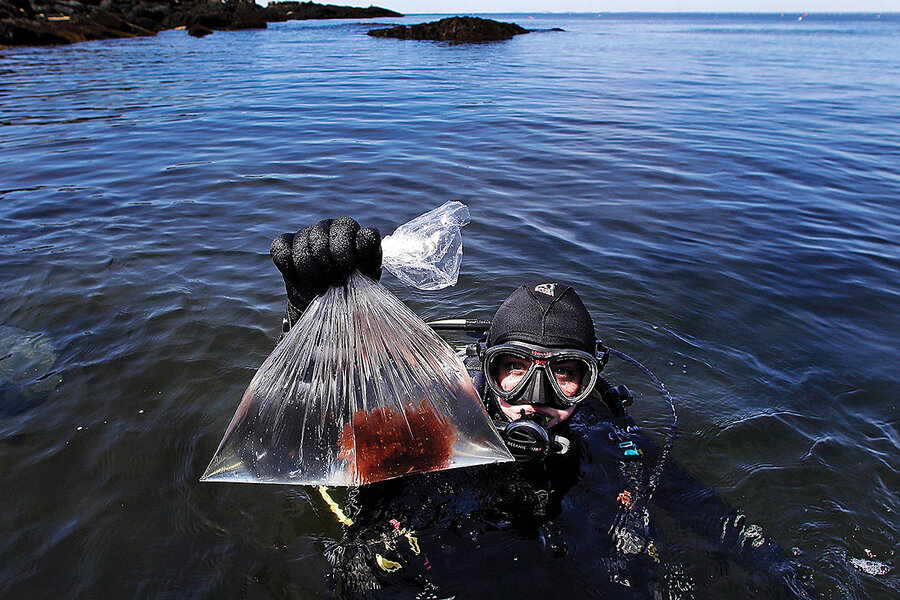Seaweed fudge, anyone? Maine lobstermen try a new, watery crop.
Loading...
Joe Young symbolizes a transformation on the Maine coast. After relying on lobstering for almost 40 years, he now grows oysters and also kelp in a tidal pool on his property. And, even as lobster remains king of Maine’s maritime industry, Mr. Young plans to expand as part of a booming aquaculture business in the state.
Cultivating seaweed allows fishermen a hedge against the uncertainties of lobstering. And seaweed beds absorb the carbon dioxide that has made waters less habitable for marine life, according to the Bigelow Laboratory of Ocean Sciences. The World Bank has touted nutrient-rich seaweed as one potential solution to global food insecurity.
Why We Wrote This
Kelp may be coming to a seafood menu near you. Not just because it’s healthy but because growing seaweed helps fishermen and the ocean environment.
“So many more people than you would think are really open-minded about seaweed,” says Josh Rogers, who owns Heritage Seaweed, a Portland, Maine, shop. Some evidence: This May’s kelp harvest coincided with Maine’s first Seaweed Week, which drew foodies to a crawl of more than 60 Portland eateries that offered seaweed-inspired delights.
“We have a seaweed fudge,” Mr. Rogers says. “That always makes people giggle.”
When Luke’s Lobster opened a wharfside restaurant in Portland, Maine, in early June, there was more to the menu than the brand’s signature crustacean. For one, a summer salad features a kelp buttermilk dressing.
Luke’s Lobster co-founder Ben Conniff sings seaweed’s praises. “It’s great for the environment. It’s extremely healthy,” he says.
The dish is emblematic of a turning tide in Maine. The seafood company prides itself on the sustainable business it has built with Maine fishermen, who increasingly look to aquatic crops like kelp for off-season income. Mr. Conniff says he wants to help “ease people into the conversation about how great [seaweed] is.”
Why We Wrote This
Kelp may be coming to a seafood menu near you. Not just because it’s healthy but because growing seaweed helps fishermen and the ocean environment.
In a state where lobster is king – an industry with a billion-dollar economic impact each year – aquaculture, or the farming of aquatic species, is becoming a contender.
Maine has around 150 aquaculture lease sites for operations that include oysters, finfish, and seaweed. In the decade since 2007, the total economic impact of Maine’s aquaculture has almost tripled, to $137 million, according to a report from the University of Maine.
China and Indonesia produce the bulk of the world’s seaweed, mostly for human consumption. But Maine has become an aquaculture leader in the U.S. as home to the country’s first commercial seaweed farm, Atlantic Sea Farms. It helps that seaweed aquaculture tends to be less capital-intensive than fishing.
Off-season income aside, cultivating seaweed allows fishermen a hedge against lobster’s uncertain future. With changing industry practices, a bait crisis, and warming waters affecting lobster fishing, an environmentally friendly crop like cultivated kelp seems like a good option to many.
“I don’t think anyone is disputing that the Gulf of Maine is a different place now than it was 30 years ago,” says Merritt Carey, board member of the Maine Seaweed Council and founder of Tenants Harbor Fisherman’s Co-op.
Wild kelp isn’t immune to that shifting world, either. Climate change and invasive species are contributing to the decline of Maine’s southern seaweed beds, according to researchers.
But that’s where kelp farmers can help: Cultivated beds absorb the carbon dioxide that has made waters less habitable for marine life, according to the Bigelow Laboratory of Ocean Sciences. And seaweed is a “zero-input crop” that doesn’t need pesticides or soil to flourish. The World Bank has touted nutrient-rich seaweed as one potential solution to global food insecurity.
Despite its sustainability, aquaculture comes with controversy. Lobstermen compete to fish in places that are also desirable as aquaculture sites, and homeowners are protective of their waterfront properties. Maine’s Department of Marine Resources might amend its rules regulating the size and location of aquaculture leases.
Training programs, such as the Maine Sea Grant’s “Aquaculture in Shared Waters,” help fishermen transition into aquaculture. The 11-week course offers aquaculture training that covers topics like site selection and financial management.
“There’s a very strong and very intentional outcome of this – meeting your colleagues and making a professional network. That helps to build community,” says program leader Dana Morse, extension associate for the Maine Sea Grant program and University of Maine Cooperative Extension.
Joe Young from Corea, Maine, was an inaugural student. A sixth-generation fisherman, Mr. Young relied on lobstering for almost 40 years. But in 2013, he realized his lucrative industry was weathering some uncertainty.
News of the Aquaculture in Shared Waters program piqued his curiosity; he cobbled together enough fishermen to hold a class. Now semi-retired, he grows oysters and kelp in a tidal pool on his property and plans to expand.
Mainers are keen to spread the gospel of seaweed to grow local demand. Luke’s Lobster provided a grant through its Keeper Fund to research kelp’s ability to curb ocean acidification.
This May’s kelp harvest coincided with Maine’s – and possibly the country’s – first Seaweed Week, a food crawl of more than 60 Portland eateries that offered seaweed-inspired delights. Josh Rogers, the event’s producer, said foodies came from as far away as Washington, D.C.
“So many more people than you would think are really open-minded about seaweed,” says Mr. Rogers, who sells homemade seaweed tea. “They just don’t know how to get it into their diets.”
Mr. Rogers owns Heritage Seaweed, a Portland shop that claims to be the first of its kind in North America dedicated to the trending algae. He says people are familiar with seaweed cosmetics, but surprised to find it in so many edible forms.
“We have a seaweed fudge,” he says. “That always makes people giggle.”
Editor’s note: This article has been updated to clarify the economic impact of Maine’s lobster industry.








